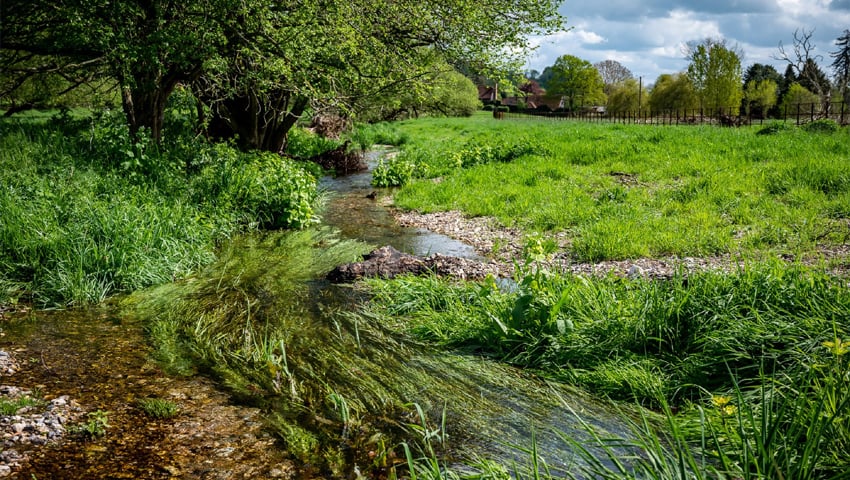A new report says that there is an urgent need for large-scale funding of nature-based solutions across many landscapes if the UK is to achieve net zero, environmental, social and health transformations. At present, investment is largely piecemeal, tends to be project-based and scattered rather than place-based and connected, and therefore the scope for the systemic change needed is limited.
The report, Aggregation and Investment for Nature, reflects on research undertaken by North Star Transition in 2023. It assesses the views of financial sector participants, exploring what they need in order to invest in nature-based solutions, at scale, across a landscape.
North Star Transition say that they started with two key questions: what do investors want, and what do the assets they will invest in look like?
They approached the project by asking financial institutions these questions directly, through bilateral conversations and through a facilitated workshop. They say that large-scale landscape funding has a greater chance of success if financial institutions co-create the funding instruments needed.
The dialogue revealed preferences around revenue streams, costs, risks, financial and operational structure and appropriate governance:
Revenues, Costs and Risks – These are the core considerations for investment committees around which clarity is essential. Four revenue streams were identified; carbon and biodiversity credits, payments for renewable energy, value add from flood management and improved resilience through regenerative agriculture. The risks – from governance to operations – were multiple and some are known, while others are unknown, some are quantifiable and others unquantifiable.
Financial Structure – North Star tested three models with participants: project finance based, counterparty based or a platform driven hybrid. The pros and cons of each are summarised in the report.
Organisational Structure and Governance – The dialogue revealed a tension between the need for a well-known entity with a strong credit rating, possibly with equity involvement, to stand behind any project, and the importance of a place-based organisation with strong local ties and a focus on social impact and the public good. The report proposes ideas to resolve those tensions.
North Star said that, “The research has established that high-quality, well-structured projects, which address aspects across finance and a fair sharing of the benefits of the monetisation with local communities, are credible tools for investment. However, further work needs to be done to make a landscape-scale transformation into an investable proposition.
“Using the intelligence gained from the dialogue, the next step is to address the issues raised through this initial engagement. The process should involve co-production with potential investors with the overall goal to develop an investment structure or vehicle, which can be deployed across a landscape and then replicated across other landscapes.”
They conclude that, “It is clear that there is an appetite within mainstream financial institutions to participate in the development of the tools and products needed to enable landscape transformation. This is an opportunity not to be missed, since financial institutions are rather more likely to regard as credible the initiatives they have co-developed. Such an ‘outside-in’ innovation process contrasts with the “inside-out” process that is at the heart of many existing landscape finance initiatives.”
Reflecting on the report, Kim Connor-Streich from Greenshank Environmental said, “Some really interesting points. The most interesting thing about BNG is that it doesn’t really scale down for individual standalone sites. The sums needed to enable landowners/farmers to do these schemes are just not enough for larger investors to be interested. The organisations who have taken institutional money are all looking to secure long-term agreements/buy the land and the majority of the costs are in the buying land/leases. The majority of the benefit then flows to the new organisation.
“Where the landowners are looking at doing these types of things themselves (especially biodiversity net gain and nutrient neutrality), the biggest issue is the friction of quantifying what is possible with minimal/no investment. Developers are only keen to put their hands in their pockets when they know something is viable (or they heavily discount the price they are willing to pay). We have tried to remove this friction by taking on this risk and it seems to be popular.
“The BNG market has loads of uncertainty around supply and demand and so there are and will be for the next few years some good margins to be made. Investors are typically looking for 15% ARR. This means these new companies need to be looking at very significant returns in order to buy the land (often at above agricultural land value), develop and make a profit. It also means a lot have BNG units they may struggle to sell if the market drops too far.”
Connor-Streich concluded, “This presents a real opportunity for the landowners who are looking at schemes themselves as they will have very different cost structures.”
Read the North Star Transition report, Aggregation and Investment for Nature
Read the article in its original location
Image by Jyoti Banerjee, courtesy of North Star Transition
